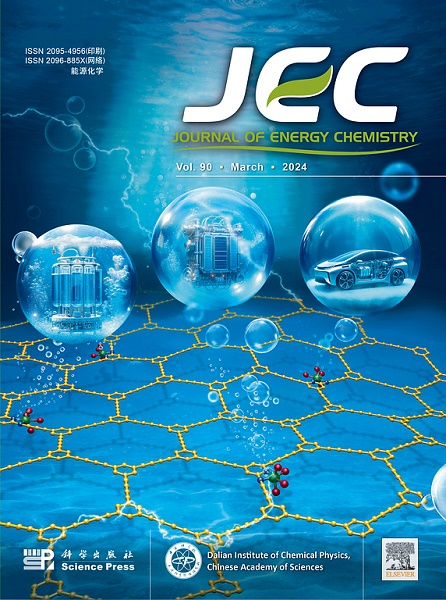Symmetry-broken atomic ensemble induced by mandated charge for efficient water dissociation in hydrogen generation
IF 13.1
1区 化学
Q1 Energy
引用次数: 0
Abstract
Efficient water dissociation catalysts are important for reducing the activation energy barrier of water molecules in the field of energy conversion. Herein, symmetry-broken Rh ensemble induced by mandated charge was established to boost the catalytic activity toward water dissociation. As an experimental verification, the turnover frequency of 1.0-RTOV4 in hydrogen generation from ammonia borane hydrolysis reaches up to 2838 min−1 (24828 min−1 depend on Rh dispersion), exceeding the benchmark set up by state-of-the-art catalysts. The transfer of mandated charge from OV to Rh near OV breaks the local symmetry of Rh nanoparticle and forms Rhγ− (electron-aggregation Rh)-Rh interfacial atomic ensemble. This symmetry-broken Rh ensemble is the reason for the high activity of the catalyst. This work provides an effective electronic regulation strategy based on symmetry-broken atomic ensemble induced by mandated charge, designed to stimulate the limiting activity of metal catalyst in the field of next generation energy chemistry.

求助全文
约1分钟内获得全文
求助全文
来源期刊

Journal of Energy Chemistry
CHEMISTRY, APPLIED-CHEMISTRY, PHYSICAL
CiteScore
19.10
自引率
8.40%
发文量
3631
审稿时长
15 days
期刊介绍:
The Journal of Energy Chemistry, the official publication of Science Press and the Dalian Institute of Chemical Physics, Chinese Academy of Sciences, serves as a platform for reporting creative research and innovative applications in energy chemistry. It mainly reports on creative researches and innovative applications of chemical conversions of fossil energy, carbon dioxide, electrochemical energy and hydrogen energy, as well as the conversions of biomass and solar energy related with chemical issues to promote academic exchanges in the field of energy chemistry and to accelerate the exploration, research and development of energy science and technologies.
This journal focuses on original research papers covering various topics within energy chemistry worldwide, including:
Optimized utilization of fossil energy
Hydrogen energy
Conversion and storage of electrochemical energy
Capture, storage, and chemical conversion of carbon dioxide
Materials and nanotechnologies for energy conversion and storage
Chemistry in biomass conversion
Chemistry in the utilization of solar energy
 求助内容:
求助内容: 应助结果提醒方式:
应助结果提醒方式:


